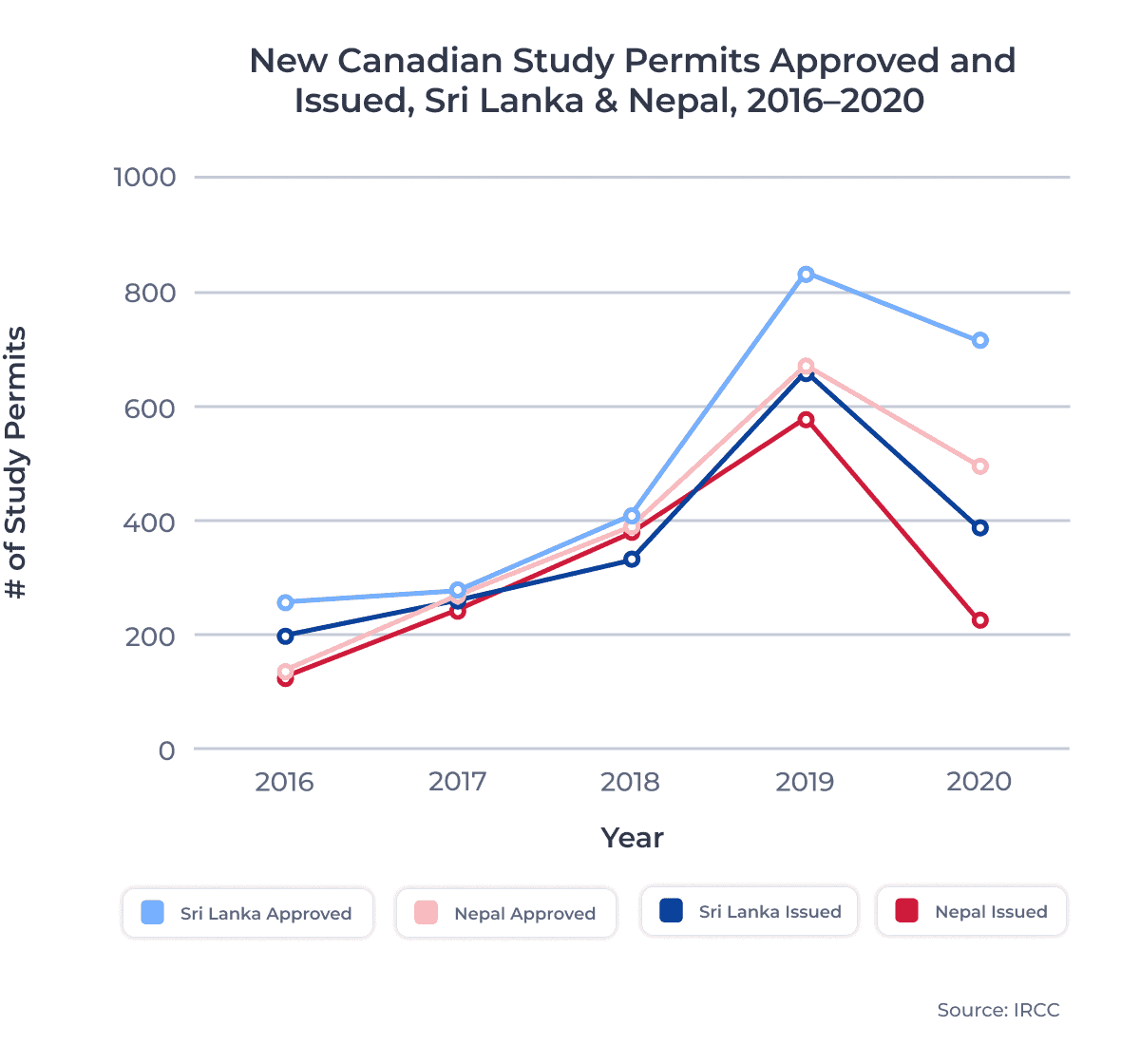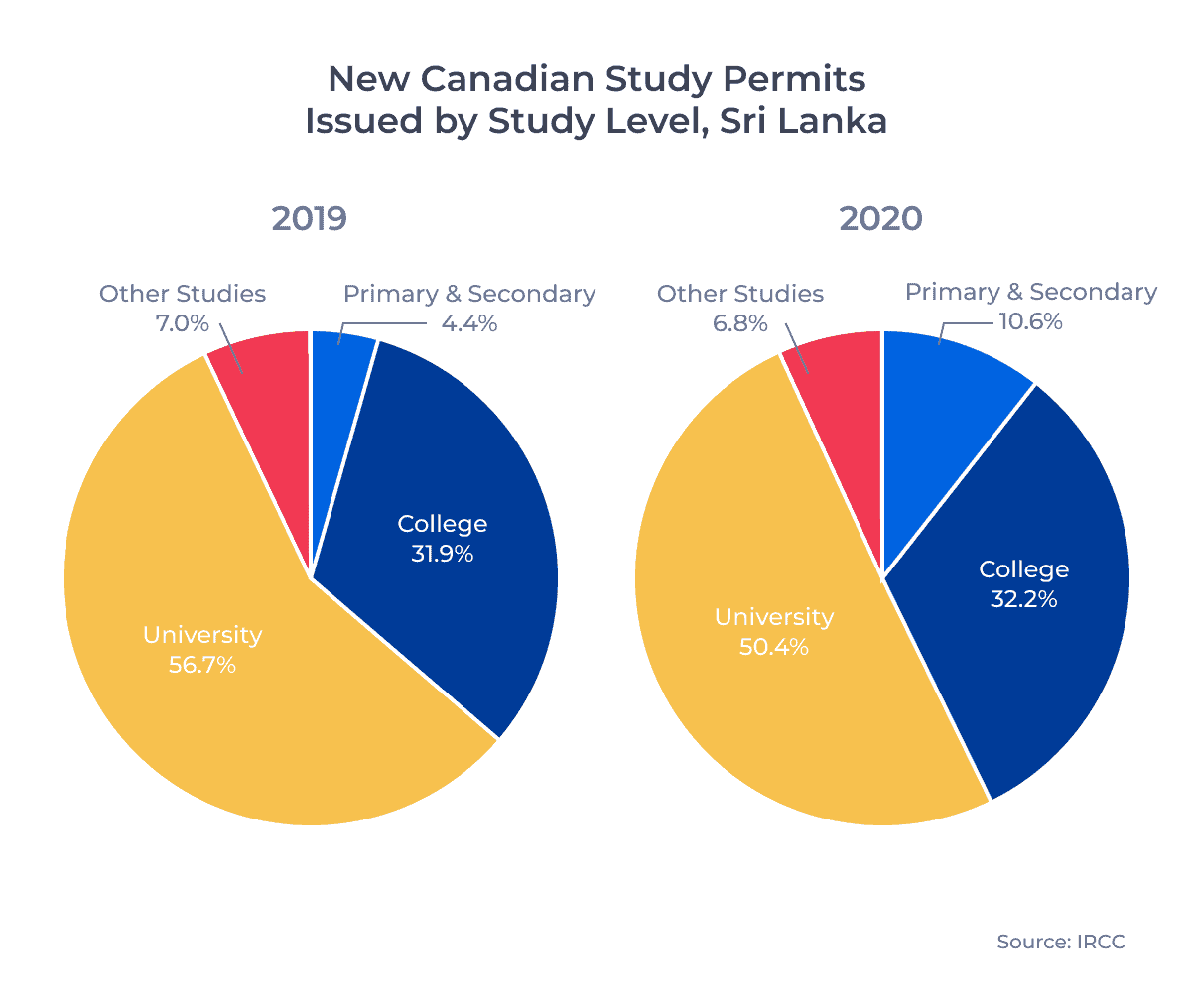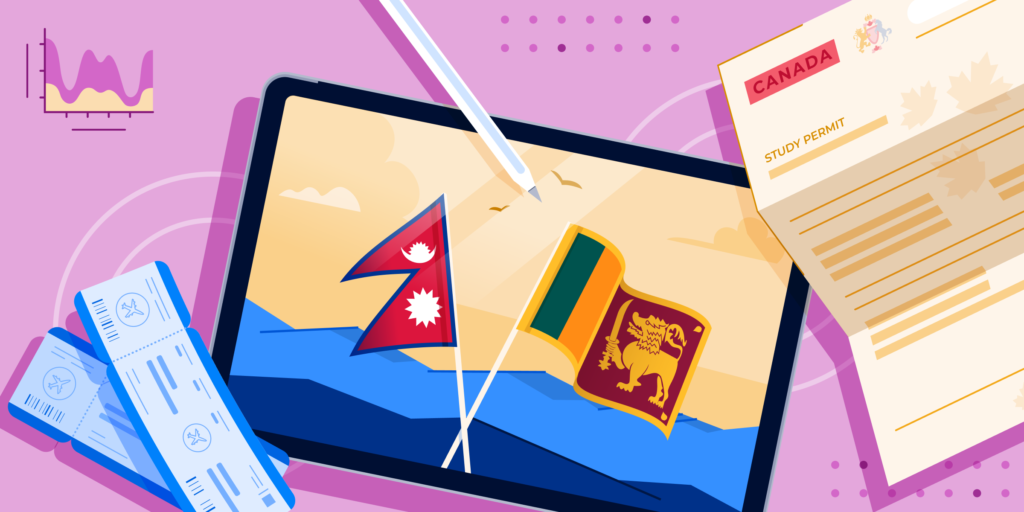While the COVID-19 pandemic has had severe impacts on economies and industries around the world, it has also presented some new opportunities. Certain industries, such as tele-health and digital communications, have experienced substantial growth and booming demand. For the Canadian international education sector, the pandemic has presented an opportunity for schools to capture a larger share of the Sri Lankan and Nepali student market. Prolonged closures in Australia and restrictive policies in the United States are driving high Sri Lankan and Nepali interest in Canadian institutions.
In today’s ApplyInsights, I’ll be spotlighting student visa numbers1 and trends for Sri Lankan and Nepali students over the past five years. I’ll discuss how these two important South Asian markets2 have changed and grown over time, and I’ll outline how the pandemic has impacted these markets. I’ll also take a look at what and where Sri Lankan and Nepali students are studying in Canada. Finally, I’ll give my thoughts on what Canadian institutions can do to take advantage of the high interest in Canadian studies among Sri Lankan and Nepali students.
Key Insights at a Glance
- Approved study permits for Sri Lankan and Nepali students skyrocketed from 2018 to 2019, jumping up 105% and 74%, respectively.
- Manitoba, Newfoundland and Labrador, and PEI are popular university destinations for Sri Lankan and Nepali students due to lower tuition and living costs.
- College studies are becoming more popular among students from both countries as knowledge about Canadian permanent residency pathways grows.
This is the eighth article in our ApplyInsights series diving into the top international student markets for Canadian institutions. I previously looked at Hong Kong, Algeria, Brazil, China, the Philippines, Bangladesh, and Vietnam, and I’ll cover a few more key markets in the coming months.
Canadian Study Permit Applications and Approval Rate – Sri Lanka & Nepal
The number of study permit applications submitted by Sri Lankan and Nepali nationals ballooned pre-pandemic, growing 250% for both markets from 2016 to 2019. In 2020, Nepali students submitted more than 1,200 study permit applications. Though this was a drop of 56% from 2019, it remained in line with the year-over-year decline of 55% for all South Asian markets. By contrast, the Sri Lankan market was incredibly resilient. Applications from Sri Lankan students only fell by 13%, significantly outperforming the all-market decrease of 48%.
One of the key differences between these two markets over the past five years was approval rates. The approval rate for Sri Lankan students remained around 45% from 2016 to 2020, below the all-market average of over 60%. The Nepali market saw approval rates rise from 17% in 2016 to 25% in 2017, where they stalled before jumping up to 41% in 2020.
The following table summarizes the year-over-year study permit changes for the Sri Lankan and Nepali markets:
| 2019 | 2020 | Change | ||
|---|---|---|---|---|
| Sri Lanka | Applications | 1,823 | 1,580 | -13.3% |
| Approvals | 833 | 714 | -14.0% | |
| Approval Rate | 45.7% | 45.2% | -0.5 | |
| Nepal | Applications | 2,733 | 1,214 | -55.6% |
| Approvals | 672 | 493 | -26.6% | |
| Approval Rate | 24.6% | 40.6% | +16.0% | |
| All Markets | Applications | 425,990 | 220,932 | -48.1% |
| Approvals | 256,216 | 113,304 | -55.8% | |
| Approval Rate | 60.1% | 51.3% | -8.8 |
The difference in approval rates had a huge influence on new student populations from these markets. Although Nepali students submitted 900 more study permit applications in 2019, 150 more Sri Lankan students were accepted.
But the tides began to shift in 2021. Through the first four months of 2021, the approval rate for Sri Lankan students fell slightly to 42%. The approval rate for Nepali students vaulted to an incredible 88%, more than doubling their approval rate from 2020. While it’s likely that this rate will fall somewhat as the year progresses, nearly as many Nepali students were accepted between January and April 2021 as in all of 2020.
Canadian Study Permits Issued – Sri Lanka & Nepal
From 2016 to 2019, 90% of study permits for Nepali students and 82% of study permits for Sri Lankan students were issued.3 Due to the pandemic and related travel restrictions in 2020, these rates fell to 45% and 54%, respectively. Though significant, these declines were much less than the average among all South Asian markets. Only 35% of all new study permits approved for South Asian students were issued in 2020.
In 2020, Nepal and Sri Lanka had the highest and second-highest study permit issued rates among major South Asian markets.4 The chart below presents a comparison of study permits approved and issued for Sri Lankan and Nepali students over the last five years:
Canadian Study Permits Issued by Province – Sri Lanka & Nepal
The maps below show the number of study permits issued to Sri Lankan and Nepali students for studies in each of Canada’s provinces in 2020. They also include the change in study permits issued between 2019 and 2020:
In 2019, 5% of all new international students were issued study permits for schools in Manitoba or Nova Scotia. By comparison, nearly 20% of all Nepali and Sri Lankan students were issued permits for institutions in those provinces. This rate dropped to 15% for Nepali students in 2020, and it fell even further for Sri Lankan students, to just 8%.
I expect that Nepali and Sri Lankan students will return to Manitoba and Nova Scotia once more post-pandemic. One of the main draws for schools in these provinces is lower tuition and cost of living. Nepali and Sri Lankan students are price-conscious and institutions in these provinces offer similar opportunities and permanent residency (PR) pathways as more expensive destinations. I anticipate that other lower cost destinations, such as the rest of Atlantic Canada, may see a rise in Nepali and Sri Lankan student applications in 2021 and 2022.
Canadian Study Permits Issued by Study Level – Sri Lanka & Nepal
Next, let’s look at what Sri Lankan and Nepali students are studying in Canada. University studies remain the primary draw for students from Sri Lanka and Nepal.6 However, college studies are growing in popularity in both markets, largely due to lower tuition costs and growing understanding of the Canadian education system. For all post-secondary studies, Nepali and Sri Lankan students are highly interested in nursing and health studies, information technology (IT), and project management.
The following charts show the change in the distribution of new study permits issued to Sri Lankan students by study level in 2019 and 2020:
The charts below show the same issued study permit data, but for the Nepali market:
Major Factors Influencing Sri Lankan and Nepali Students
In speaking with our recruitment partners, it’s clear that before the pandemic, students from Nepal and Sri Lanka looked to Australia as their preferred study abroad destination. This was not only due to Australia’s proximity to those countries, but also because of a lack of application fees and rapid letter of acceptance (LOA) and visa processing times. Many students also saw the US as a top destination, but the restrictive policies of the Trump administration caused some students to look for a more welcoming environment.
During the height of the pandemic in 2020, while the UK was the next choice for some Sri Lankan and Nepali students, many more turned to Canada as a safe destination with strong immigration and work opportunities. Highly qualified students applied to Canada instead of other destinations, helping to maintain or raise the approval rate for both markets. As more students were approved, more students saw Canada as a viable destination, and market knowledge about the Canadian education system grew within both countries.
I anticipate that this new interest in the Canadian market will extend well beyond the end of the pandemic. This improved market knowledge has and will continue to help students understand that Canadian college studies offer high-quality education and work permit eligibility with lower tuition fees. Many students have also discovered Canada’s Post-Graduation Work Permit Program (PGWPP), an exciting possibility for achieving PR.
Key Takeaways
Sri Lankan and Nepali students are looking at Canada as a top study abroad destination more than ever before. Canadian institutions should use this opportunity to actively recruit from these growing South Asian markets. If Canadian schools can capture a larger market share from these countries, there’s a better chance that Canada will remain top of mind when the US and Australia fully reopen to international students.
There are some key steps that Canadian institutions can take to remove current barriers for Sri Lankan and Nepali students. Though schools cannot affect long visa processing times, they can reduce LOA turnaround times. Shorter LOA turnaround times have a direct impact on enrollment rates, and the window of opportunity for Canadian schools won’t last forever.

Institutions can also offer scholarships and application fee waivers to reduce costs for Sri Lankan and Nepali students. But a unique change that would benefit these two markets would be offering supplementary courses or credit waivers for certain high school course requirements. For example, many Canadian nursing programs require Grade 12 math. However, an equivalent course is not offered at all Nepali high schools every year. Enabling students to work around this requirement could have a large positive impact on enrollment from these growing markets.
Now’s the time for Canadian institutions to recruit students from Nepal and Sri Lanka. Canadian schools that want to grow their market share during this exciting time should:
- Promote scholarships, grants, or bursaries for Nepali and Sri Lankan students who may have diminished financial means
- Work to reduce letter of acceptance processing times and develop high school credit requirement options to encourage student enrollment
- Provide resources and supports for Nepali and Sri Lankan students pursuing post-graduation PR pathways, especially PGWPP
Published: August 11, 2021
Subscribe to ApplyInsights
Sign up for the latest insights on international education.
 Meti Basiri
Meti Basiri
Co-Founder and Chief Marketing Officer (CMO)
Meti is driven by the belief that education is a right, not a privilege. He leads the International Recruitment, Partner Relations, and Marketing teams at ApplyBoard, working to make education accessible to people around the world. Meti has been instrumental in building partnerships with 1,500+ educational institutions across Canada, the United States, the United Kingdom, and Australia. Working with over 7,500 international recruitment partners, ApplyBoard has assisted more than 200,000 students in their study abroad journey. Follow Meti on LinkedIn for more access to ApplyInsights and key industry trends.
FOOTNOTES:
1. The terms student visa and study permit are generally used interchangeably for Canadian international students. Rather than student visas, Canada provides accepted international students with study permits, which allow those students to enroll in classes at Canadian institutions. When a student is accepted for a study permit, they are also usually provided with a visitor visa, which allows that student to enter Canada for their studies. Statistics used in this article are for new study permits only. All data courtesy of Immigration, Refugees and Citizenship Canada (IRCC), except where noted.
2. The South Asian market includes India, Bangladesh, Pakistan, Sri Lanka, Nepal, Bhutan, Afghanistan, and the Maldives.
3. Study permits approved and study permits issued are not the same. An applicant with an approved study permit may not be issued a study permit for a variety of reasons.
4. For all South Asian markets with at least 100 approved study permits in 2020.
5. More study permits can be issued than approved in a given year as study permits are only issued when a student arrives in Canada, so a student who was approved for a study permit in 2020 but arrived in Canada in 2021 due to pandemic travel restrictions would be counted in this data.
6. Of the large other studies sector for Nepali students, most of those students enrolled in either post-graduate certificate or advanced diploma programs after completing a three-year Bachelor’s program in Nepal.



